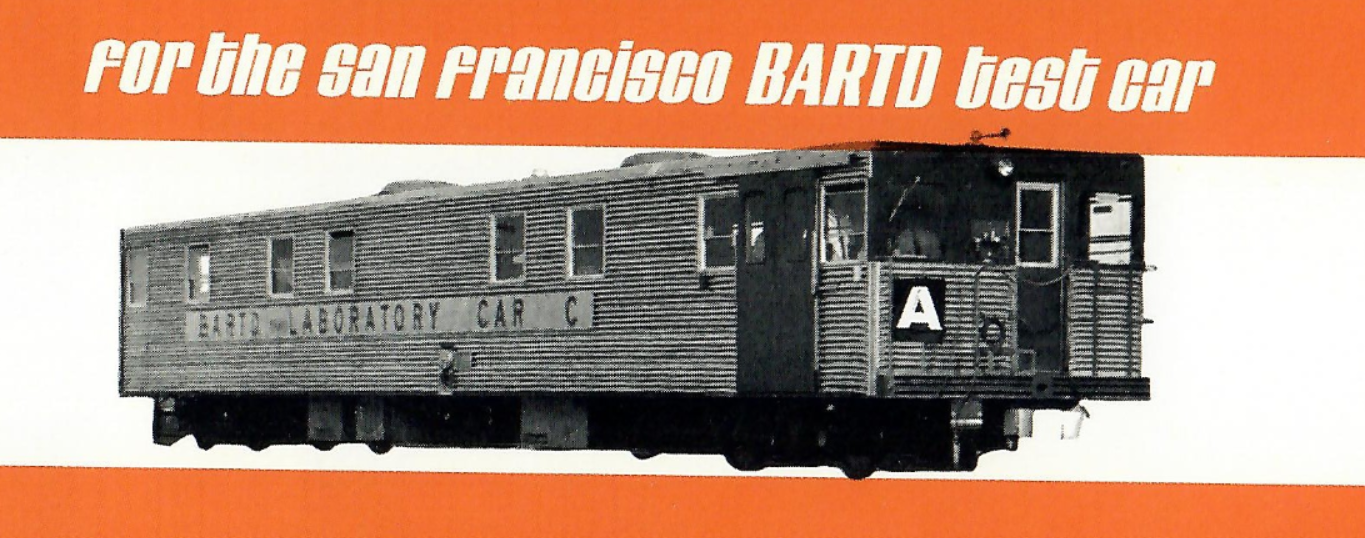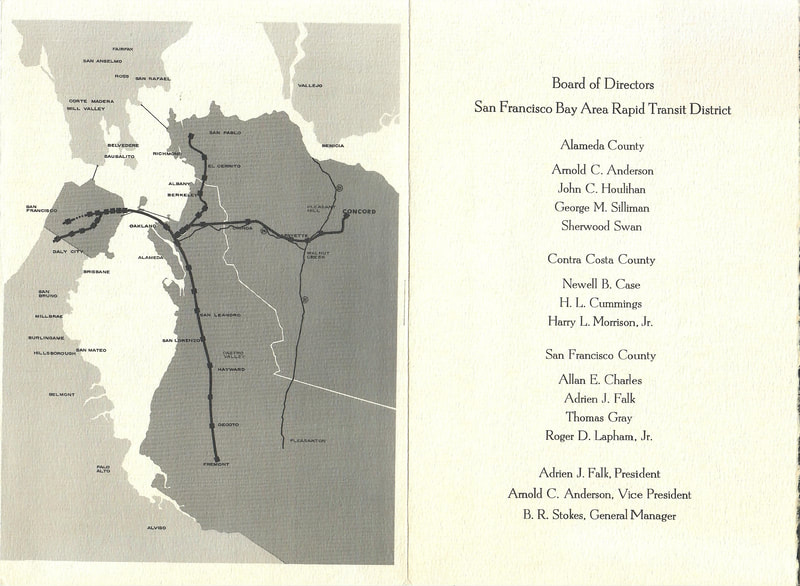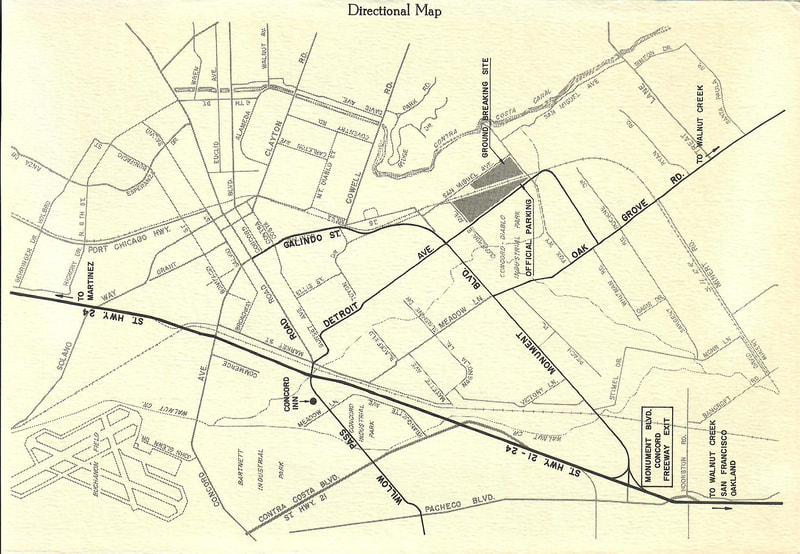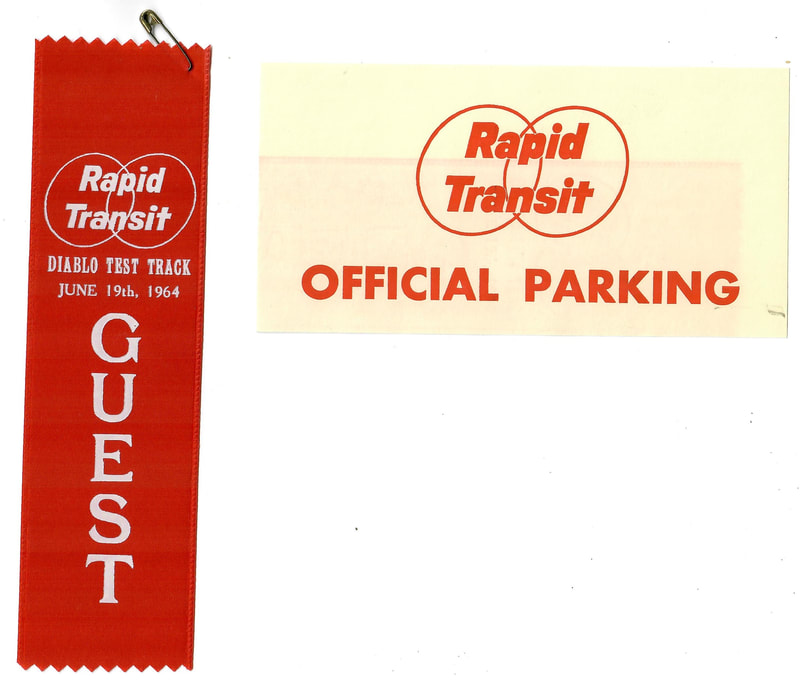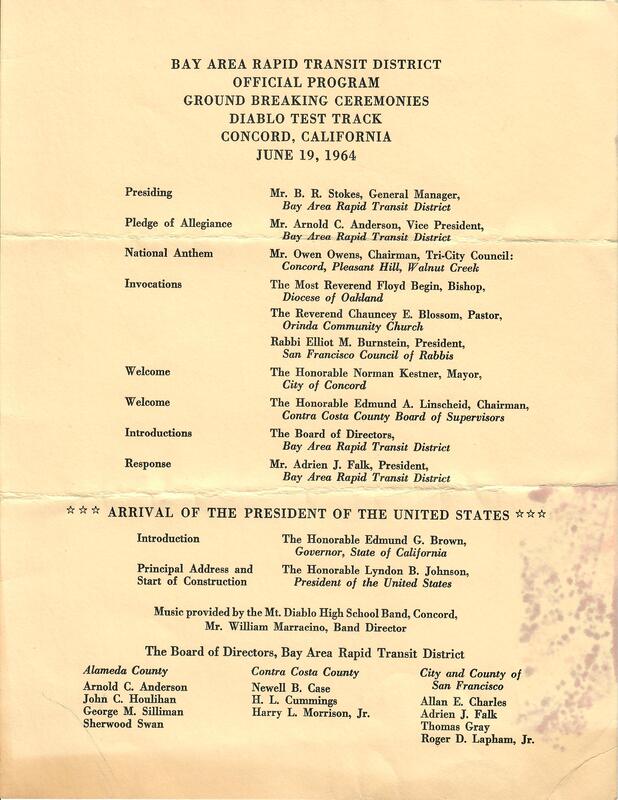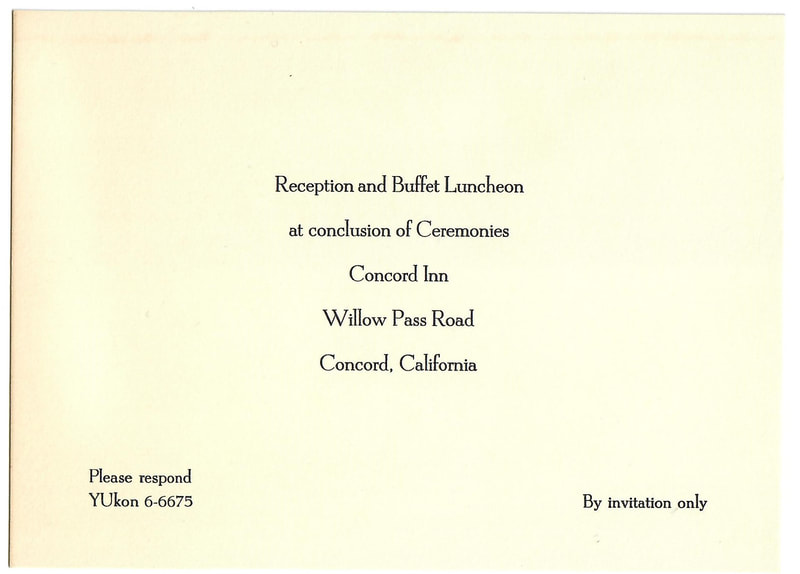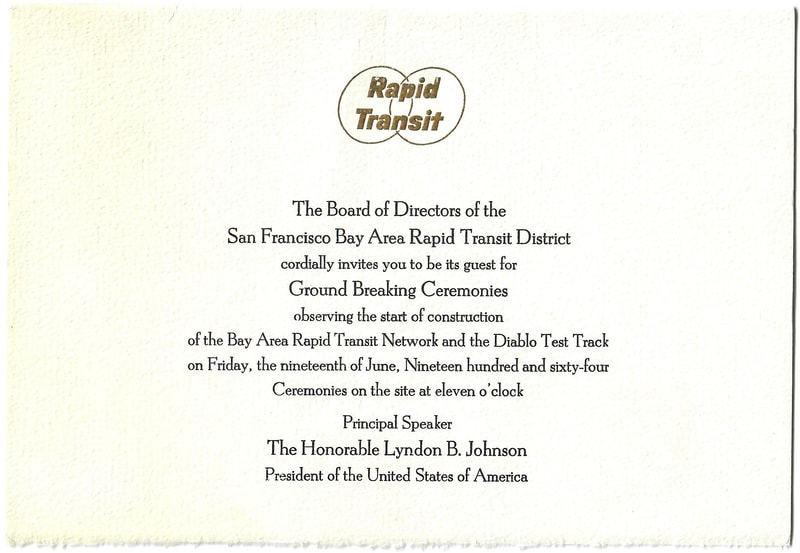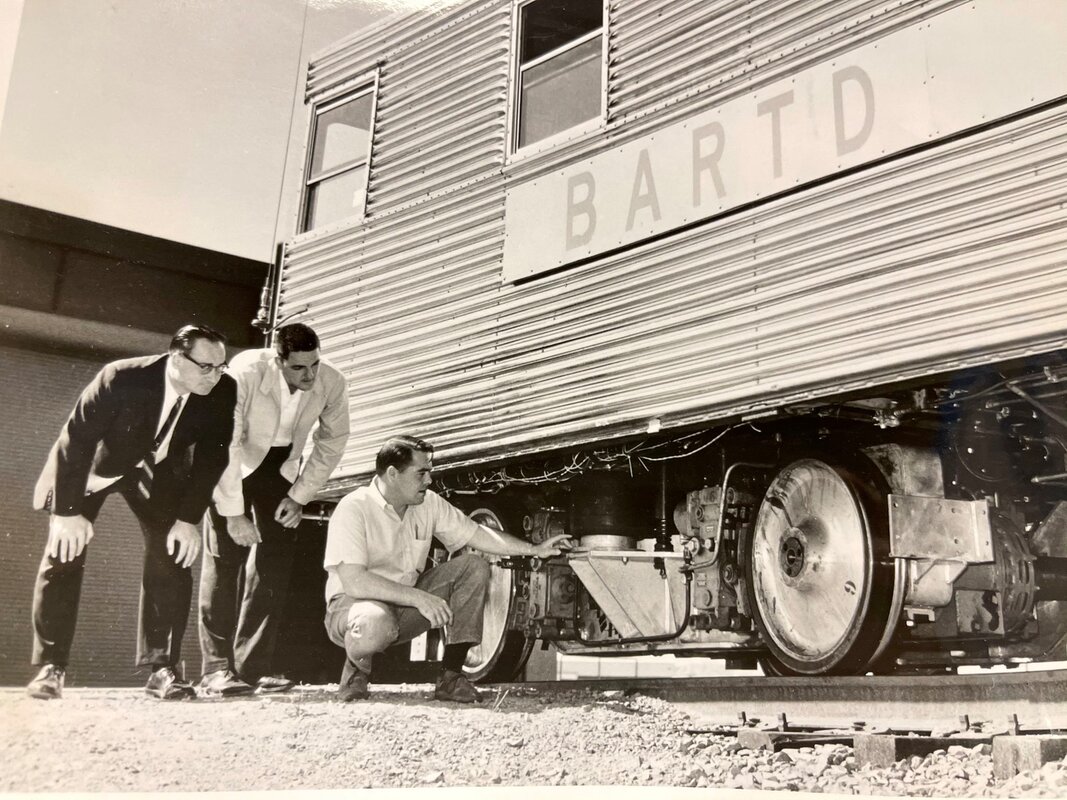The first BART Electrically Powered Rail Cars - the Laboratory Cars
|
BARTD’s first electrically powered railcars were fluted metal boxes designed for operation on the 4.4 mile Diablo Test Track in central Contra Costa County. The three cars, lettered A, B, and C, were publically nicknamed “Agnes,” “Betsey,” and “Claire” respectively.
Various types of trucks, wheels, propulsion systems, brake systems, couplers, gear boxes, ATC systems, and current collectors were evaluated on the three cars. Data from these laboratory cars was partially used to write the specifications for the eventual revenue BART fleet. |
The Diablo Test Track
From the San Francisco Bay Area Rapid Transit District Demonstration Project Technical Reports:
The San Francisco Bay Area Rapid Transit District Demonstration Project was conducted on a four and one-half mile test track between the cities of Concord and Walnut Creek, California. This Program was financed in part by three Mass Transpiration Demonstration Grants from the Department of Housing and Urban Development (formerly HHFA) of the United States Government.
The Test Track was operated by the Joint Venture firm of Parsons Brinckerhoff-Tudor-Bechtel, General Engineering Consultants to the District, who prepared this report and others in this series.
The purpose of the Demonstration Project was to test and evaluate the new technical concepts in the field of rapid transit. These concepts included a variety of advanced hardware as well as completely automatic train control and automatic fare collection systems. These systems and concepts were evaluated into the design of the BART system...
The success of this Demonstration Project was due in part to the cooperation and contributions of both time and material on the part of many manufacturers in the transit industry.
A/N: The route of the Diablo Test Track is still used by BART today, as part of the C Line from outside Walnut Creek to Concord Yard.
The San Francisco Bay Area Rapid Transit District Demonstration Project was conducted on a four and one-half mile test track between the cities of Concord and Walnut Creek, California. This Program was financed in part by three Mass Transpiration Demonstration Grants from the Department of Housing and Urban Development (formerly HHFA) of the United States Government.
The Test Track was operated by the Joint Venture firm of Parsons Brinckerhoff-Tudor-Bechtel, General Engineering Consultants to the District, who prepared this report and others in this series.
The purpose of the Demonstration Project was to test and evaluate the new technical concepts in the field of rapid transit. These concepts included a variety of advanced hardware as well as completely automatic train control and automatic fare collection systems. These systems and concepts were evaluated into the design of the BART system...
The success of this Demonstration Project was due in part to the cooperation and contributions of both time and material on the part of many manufacturers in the transit industry.
A/N: The route of the Diablo Test Track is still used by BART today, as part of the C Line from outside Walnut Creek to Concord Yard.
DIABLO TEST TRACK GROUNDBREAKING CEREMONY
Photo gallery below: click on the thumbnails to view the full size image:
Photo gallery below: click on the thumbnails to view the full size image:
Construction
|
All three cars were built by Budd, subcontracted to the Western Pacific Railroad shops in Sacramento.
Budd built the car pieces in Philadelphia, and WP assembled the car in the shop as seen in the image. The cars were then shipping to the Diablo Test Track via flatcar on a "Sacramento Northern detour train." |
Click on the thumbnails below to view the full size image.
Garrett Corporation large brochure showing their technology in Lab Car A (Agnes). ATP Transit Collection.
Garrett Corporation large brochure showing their technology in Lab Car A (Agnes). ATP Transit Collection.
Delivery
|
The time honored tradition of posed-inspection photos on BART started way back in the 60s.
Shiny new Claire is inspected by 3 early BARTonians. Car C was the first to be delivered, on March 22, 1965. “Clara (the test car) arrived at Concord from Sacramento in a special Sacramento Northern train. She rode on a WP flat car instead of on the rails since she has a 5′ 6″ gauge, nearly a foot wide than the 4' 8.5″ standard gauge used by most existing transit systems and all the nation's railroads. Parsons Brinckerhoff-Tudor Bechtel, the district's consulting engineers, said that exhaustive studies show the wide gauge provides greater stability and smoother riding qualities for the rapid transit trains.” -Western Railroader June 1965 Vol 2806 Issue 305 |
Rolling on the Diablo Test Track
Click on the thumbnails below to view the full size image.
Rebuilding and Mainline Testing
The Diablo Test Track program concluded in 1968, and in 1970, the cars B and C were rebuilt for ATO testing on the soon-to-open BART system, before the delivery of the Rohr cars.
Funny enough, Lab Car B was the reason behind the first noise complaint of an idle BART car, in October 1971. The source was traced to the single, large condensor in Car Betsey. It was stated the Rohr cars will have multiple condensors, which reduces noise.
Click on the thumbnails below to view the full size image.
Funny enough, Lab Car B was the reason behind the first noise complaint of an idle BART car, in October 1971. The source was traced to the single, large condensor in Car Betsey. It was stated the Rohr cars will have multiple condensors, which reduces noise.
Click on the thumbnails below to view the full size image.
End of the Line - Storage and Scrapping
The Lab Cars were last seen in the 1980s (stored at Hayward Yard), and scrapped shortly after.
Lab Car C, the first BART electric railcar, was scrapped in December 1982.
Lab Car C, the first BART electric railcar, was scrapped in December 1982.
BART Lab Cars Rebuilt For 22-Mile Test Run
Oakland Tribune. Sun., Jan 11, 1970.
By Harre W. Demoro, Tribune Staff Writer
BENICIA - From the flicker and snap of the welders' torches it appears the two old Bay Area Rapid Transit laboratory cars are being reduced to scrap metal.
But lab cars B and C, which sped along BART's Diablo Test Track for three years in the quest for new improvements in railway technology, are actually being rebuilt here for an even more important task.
By May, the cars will be rolling along the 22 miles of newly laid BART track between Oakland and Hayward. Westinghouse Electric Corp. is remodeling the cars for critical testing of teh automatic train control system the firm is supplying BART.
BART will be the most automated railway in the world.
The Westinghouse Electric components will operate the trains at speeds up to 80 miles an hour at intervals as close as 90 seconds. No operators will be required, only an "attendant" riding each train to halt it in an emergency.
The main structural change to the two cars consists of lowering the roofs 19 inches and rounding the edges of the roofs where they join the sides of the car, explained Sam Girdler, president of Solano Rail Car Co. The firm, in Benicia's industrial park, specializes in rebuilding wrecked freight cars. It is a subcontractor to Westinghouse Electric for the BART work.
Girdler said his firm first had to engineer the reconstruction work. It was discovered that the cars, designed by the Budd Co. of Philadelphia, and constructed in Sacramento by the Western Pacific Railroad, did not have the traditional style of railway framing. The roof and side bracing were integral parts of the car, and could not be removed without the car sagging, Girdler said.
The roofs have to be lowered and rounded so the cars will fit in subway tunnels. So much equipment was required for the first testing in Contra Costa, between Concord and Walnut Creek, (where there were no tunnels) that the cars were built as high and wide as possible.
It was never intended to use the cars for the Oakland-Hayward tests, said James R. Monroe, Westinghouse engineer assigned to the project. (A third lab car [A/N: Lab Car A] will not be used and is stored in Concord.)
By the time the first passenger cars arrives late in August the train control problems should be solved, or close to solution. This will permit BART and Westinghouse experts to pinpoint and correct problems expected with the advanced new electrical systems on the BART passenger cars.
Previous plans called for using passenger cars to isolate and correct malfunctions of both automatic train control components and the electrical system. Now, these efforts can be separated and the work will be more precise.
Car C is due to leave Benicia by the end of the month of Pittsburgh, Pa., aboard a railway flatcar. Automatic train control equipment and a new set of the advanced new electrical system will be installed on the car by Westinghouse, at its Pittsburgh plant. Car B will be taken either to Westinghouse's Emeryville plant or to BART's new shop at Hayward, for installation of equipment salvaged from Diablo Test Track operation, as well as new automatic components.
Mechanically and electrically, car C will be the closest to the passenger cars.
The project is costing BART $338,000, but it is expected the tests will save the taxpayers much more than that, because passenger trains can be placed in operation much sooner. The lab cars will be running between Oakland's Lake Merritt subway station, Eighth and Oak streets, and Hayward, for about six months. In the final months, the tests probably will be extended through the Oakland subway, as far north as 40th and Grove streets, in the median of the Grove-Shafter Freeway.
The first 10 passenger cars are to be delivered by the Rohr Corp. of Chula Vista, by December. Hopefully, passenger service between Oakland and Fremont, which requires 60 fully-tested coaches, will begin in August, 1971, BART officials said.
The two ugly but technologically sophisticated lab cars will be blazing the way.
Oakland Tribune. Sun., Jan 11, 1970.
By Harre W. Demoro, Tribune Staff Writer
BENICIA - From the flicker and snap of the welders' torches it appears the two old Bay Area Rapid Transit laboratory cars are being reduced to scrap metal.
But lab cars B and C, which sped along BART's Diablo Test Track for three years in the quest for new improvements in railway technology, are actually being rebuilt here for an even more important task.
By May, the cars will be rolling along the 22 miles of newly laid BART track between Oakland and Hayward. Westinghouse Electric Corp. is remodeling the cars for critical testing of teh automatic train control system the firm is supplying BART.
BART will be the most automated railway in the world.
The Westinghouse Electric components will operate the trains at speeds up to 80 miles an hour at intervals as close as 90 seconds. No operators will be required, only an "attendant" riding each train to halt it in an emergency.
The main structural change to the two cars consists of lowering the roofs 19 inches and rounding the edges of the roofs where they join the sides of the car, explained Sam Girdler, president of Solano Rail Car Co. The firm, in Benicia's industrial park, specializes in rebuilding wrecked freight cars. It is a subcontractor to Westinghouse Electric for the BART work.
Girdler said his firm first had to engineer the reconstruction work. It was discovered that the cars, designed by the Budd Co. of Philadelphia, and constructed in Sacramento by the Western Pacific Railroad, did not have the traditional style of railway framing. The roof and side bracing were integral parts of the car, and could not be removed without the car sagging, Girdler said.
The roofs have to be lowered and rounded so the cars will fit in subway tunnels. So much equipment was required for the first testing in Contra Costa, between Concord and Walnut Creek, (where there were no tunnels) that the cars were built as high and wide as possible.
It was never intended to use the cars for the Oakland-Hayward tests, said James R. Monroe, Westinghouse engineer assigned to the project. (A third lab car [A/N: Lab Car A] will not be used and is stored in Concord.)
By the time the first passenger cars arrives late in August the train control problems should be solved, or close to solution. This will permit BART and Westinghouse experts to pinpoint and correct problems expected with the advanced new electrical systems on the BART passenger cars.
Previous plans called for using passenger cars to isolate and correct malfunctions of both automatic train control components and the electrical system. Now, these efforts can be separated and the work will be more precise.
Car C is due to leave Benicia by the end of the month of Pittsburgh, Pa., aboard a railway flatcar. Automatic train control equipment and a new set of the advanced new electrical system will be installed on the car by Westinghouse, at its Pittsburgh plant. Car B will be taken either to Westinghouse's Emeryville plant or to BART's new shop at Hayward, for installation of equipment salvaged from Diablo Test Track operation, as well as new automatic components.
Mechanically and electrically, car C will be the closest to the passenger cars.
The project is costing BART $338,000, but it is expected the tests will save the taxpayers much more than that, because passenger trains can be placed in operation much sooner. The lab cars will be running between Oakland's Lake Merritt subway station, Eighth and Oak streets, and Hayward, for about six months. In the final months, the tests probably will be extended through the Oakland subway, as far north as 40th and Grove streets, in the median of the Grove-Shafter Freeway.
The first 10 passenger cars are to be delivered by the Rohr Corp. of Chula Vista, by December. Hopefully, passenger service between Oakland and Fremont, which requires 60 fully-tested coaches, will begin in August, 1971, BART officials said.
The two ugly but technologically sophisticated lab cars will be blazing the way.
Last Updated: 4/26/22, 8/27/22, 2/18/23

